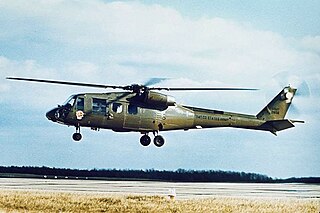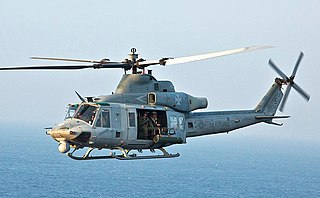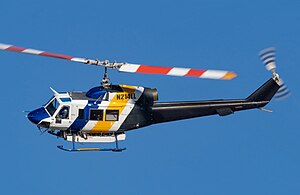
The Bell UH-1 Iroquois is a utility military helicopter designed and produced by the American aerospace company Bell Helicopter. It is the first member of the prolific Huey family, as well as the first turbine-powered helicopter in service with the United States military.

The Bell 212 is a two-blade, medium helicopter that first flew in 1968. Originally manufactured by Bell Helicopter in Fort Worth, Texas, United States, production was moved to Mirabel, Quebec, Canada in 1988, along with all Bell commercial helicopter production after that plant opened in 1986.

The Bell AH-1 SuperCobra is a twin-engined attack helicopter that was developed on behalf of, and primarily operated by, the United States Marine Corps (USMC). The twin Cobra family, itself part of the larger Huey family, includes the AH-1J SeaCobra, the AH-1T Improved SeaCobra, and the AH-1W SuperCobra.

The Kamov Ka-60 Kasatka (Russian: "Касатка", is a Russian medium twin-turbine military transport helicopter under development by Kamov. It performed its first flight on 24 December 1998.

The Hiller OH-23 Raven is a three-place, military light observation helicopter based on the Hiller Model 360. The Model 360 was designated by the company as the UH-12, which was first flown in 1948. A Hiller UH-12 was the first helicopter to make a transcontinental flight across the USA, in 1949.

The Bell 412 is a utility helicopter of the Huey family manufactured by Bell Helicopter. It is a development of the Bell 212, with the major difference being the composite four-blade main rotor. It is twin-turbine helicopter that has been popular on the civilian and military markets, and major users include Canada, Italy, and Japan. Several hundred have been produced since its introduction in 1979, and several iterations of upgrades and variations have been produced such as with upgraded cockpit electronics.

The Lycoming T53, is a turboshaft engine used on helicopters and fixed-wing aircraft since the 1950s. It was designed at the Lycoming Turbine Engine Division in Stratford, Connecticut, by a team headed by Anselm Franz, who was the chief designer of the Junkers Jumo 004 during World War II.

The Boeing Vertol YUH-61 was a twin turbine-engined, medium-lift, military assault/utility helicopter. The YUH-61 was the runner-up in the United States Army Utility Tactical Transport Aircraft System (UTTAS) competition in the early 1970s to replace the Bell UH-1 Iroquois helicopter. At the end of the flyoff program, Sikorsky Aircraft was awarded a contract to develop and build its UH-60A entry.

The Bell Model 309 KingCobra was an experimental attack helicopter developed by Bell Helicopter, based on the Bell AH-1 Cobra.

The Bell UH-1Y Venom is a twin-engine, medium-sized utility helicopter built by Bell Helicopter under the H-1 upgrade program of the United States Marine Corps. One of the latest members of the numerous Huey family, the UH-1Y is also called "Yankee" after the NATO phonetic alphabet pronunciation of its variant letter. Bell was originally to produce UH-1Ys by rebuilding UH-1Ns, but ultimately used new built airframes. In 2008, the UH-1Y entered service with the Marine Corps and also began full-rate production. The new UH-1 variant replaced the USMC's UH-1N Twin Huey light utility helicopters, introduced in the early 1970s. The helicopter were ordered by the Czech Republic and the helicopter is in production in the early 2020s.

The General Electric T700 and CT7 are a family of turboshaft and turboprop engines in the 1,500–3,000 shp (1,100–2,200 kW) class.

The Bell 204 and 205 are the civilian versions of the UH-1 Iroquois single-engine military helicopter of the Huey family of helicopters. They are type-certificated in the transport category and are used in a wide variety of applications, including crop dusting, cargo lifting, Forestry Operations, and aerial firefighting.

The Bell UH-1N Twin Huey is a medium military helicopter designed and produced by the American aerospace manufacturer Bell Helicopter. It is a member of the extensive Huey family, the initial version was the CUH-1N Twin Huey, which was first ordered by the Canadian Forces in 1968.

The Bell 214ST is a medium-lift, twin-engine helicopter descended from Bell Helicopter's ubiquitous UH-1 Huey series. Though it shares a type number with the somewhat-related Bell 214, the 214ST is larger and of quite different appearance.

The Bell UH-1 Iroquois military helicopter, first introduced in 1959, is the first production member of the prolific Huey family of helicopters, and was itself developed in over twenty variants, which are listed below.

The Sikorsky XH-39, developed by Sikorsky Aircraft in 1954, was the U.S. Army's first turbine-powered helicopter. It was fast and innovative, but ultimately rejected by the United States Army in favor of the Bell UH-1 Iroquois.
The American Aircraft Penetrator, now referred as the Aerocraft Stealth Star 204 SS, was a gunship helicopter modified from the Bell UH-1B Iroquois with tandem seating for the pilots and a troop-carrying compartment.

The Bell Huey family of helicopters includes a wide range of civil and military aircraft produced since 1956 by Bell Helicopter. This H-1 family of aircraft includes the utility UH-1 Iroquois and the derivative AH-1 Cobra attack helicopter series and ranges from the XH-40 prototype, first flown in October 1956 to the 21st-century UH-1Y Venom and AH-1Z Viper. Although not flown in military service in the USA, the Bell 412 served in Canada and Japan, and like the UH-1Y is a twin engine four rotor design based on the Bell 212.

The Honeywell T55 is a turboshaft engine used on American helicopters and fixed-wing aircraft since the 1950s, and in unlimited hydroplanes since the 1980s. As of 2021, more than 6,000 of these engines have been built. It is produced by Honeywell Aerospace, a division of Honeywell based in Scottsdale, Arizona, and was originally designed by the Turbine Engine Division of Lycoming Engines in Stratford, Connecticut, as a scaled-up version of the smaller Lycoming T53. The T55 serves as the engine on several major applications including the CH-47-Chinook, the Bell 309, and the Piper PA-48 Enforcer. The T55 also serves as the core of the Lycoming ALF 502 turbofan. Since the T55 was first developed, progressive increases in airflow, overall pressure ratio, and turbine inlet temperature have more than tripled the power output of the engine.

The Pratt & Whitney Canada PT6T Twin-Pac is a turboshaft engine designed for helicopters. Manufactured by Pratt & Whitney Canada, its first application was in the Bell 212 and UH-1N Twin Huey helicopter family. The PT6T Twin-Pac consists of two PT6A power turbines driving a common output reduction gearbox, producing up to 2,000 hp at 6,000 rpm. The engine is designated T400 by the U.S. military.























